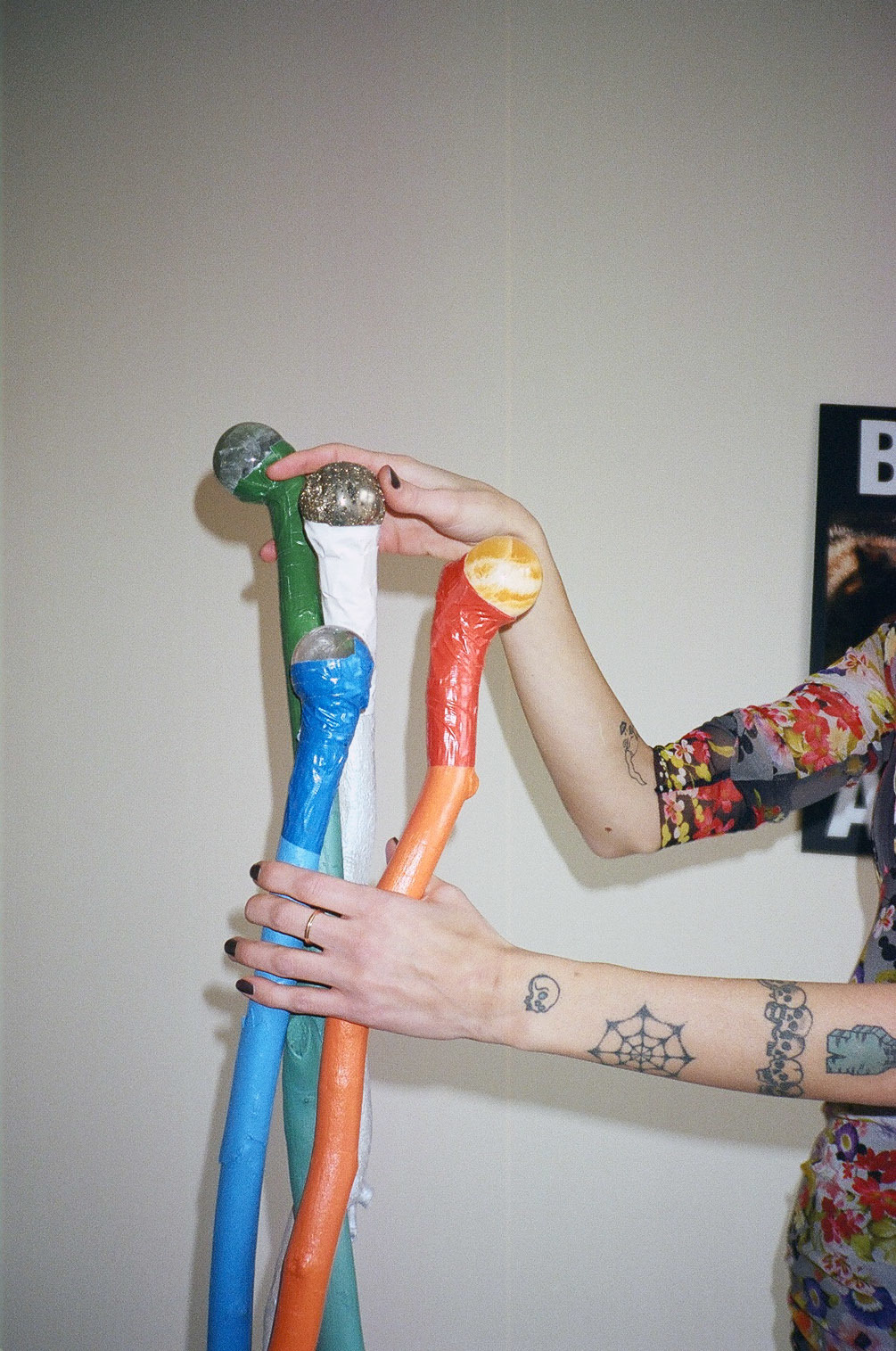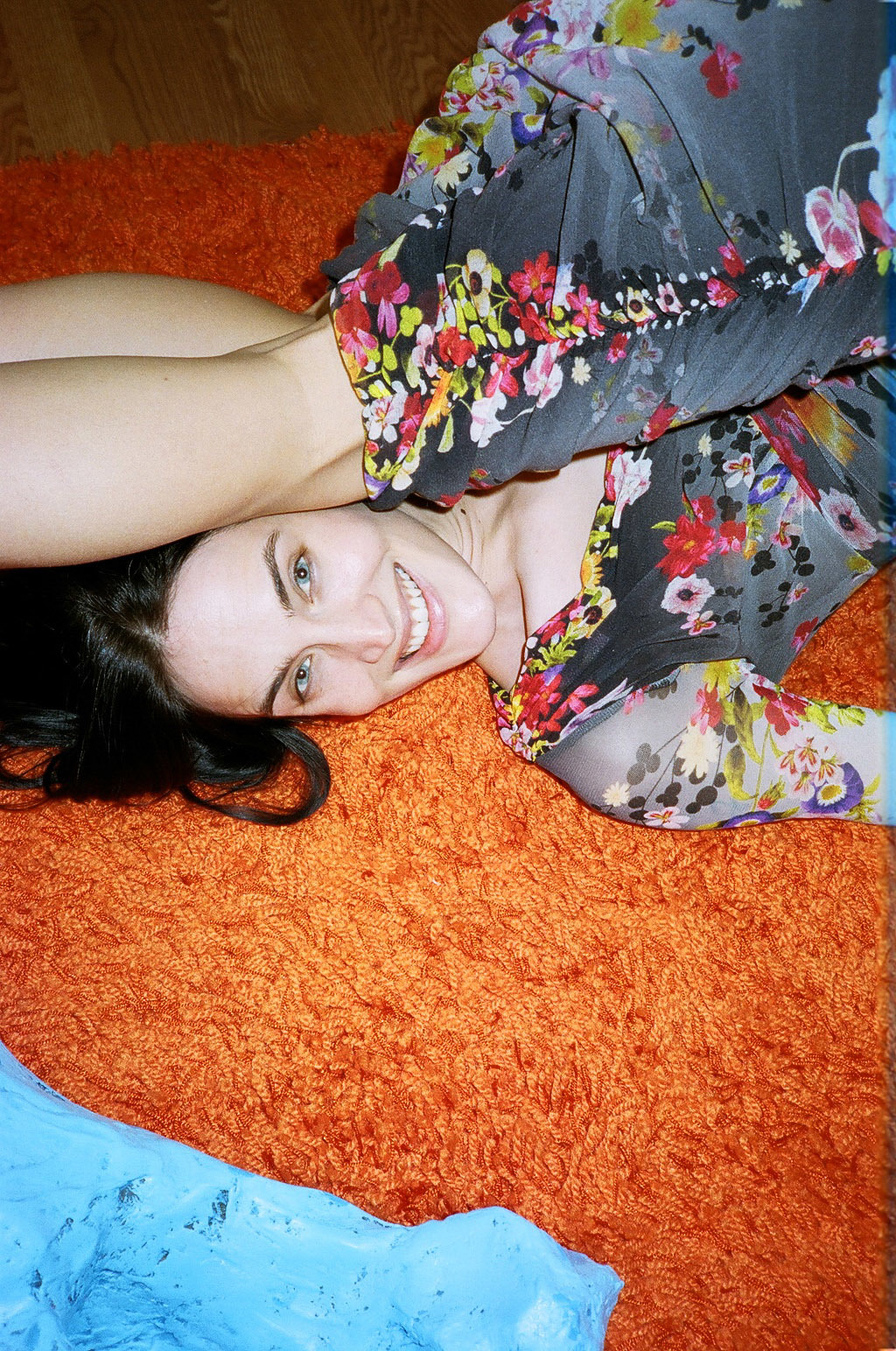Google Jane Moseley and you might come away with a certain impression. There’s the dreamy fashion video for a Rodarte collection. The party pics and portraits in fashion magazines, which bring to mind a young Jennifer Connelly. The weird thing is, none of this fits with the stuff that comes out of Moseley’s mouth. “I’m one of those sad cat people,” she jokes as I pet Human, one of her three feline housemates. “I much prefer their company to going out.”
Dark humor is Moseley’s M.O. on canvas, too. In one recent painting, abstract forms are speckled with Zombie temporary tattoos. Nearby, in a corner of her East Village apartment sits a collection of wizard staffs, fashioned out of branches and crystal balls. “I watched a lot of horror movies when I was a kid,” she notes. Plus, “I’m making a joke on the minimalist painted wood trend.”
Moseley, 27, is one of those young artists on the cusp of downtown celebrity but in search of something bigger. Unlike many of her peers, she’s not interested in the traditional path via it-girldom. “My art doesn’t have much to do with my persona,” the L.A.-native tells me. “The idea of a young attractive person in New York who hangs out with certain people is very commodifiable… but it could also be the reason you don’t get taken seriously.”

If Moseley has opinions about the artist as commodity, it’s because she’s been one. When she first moved to New York after graduating from Bard in 2009, Moseley fell in with the Still House Group, a buzzy, mostly male collective. Soon, Moseley was being asked to do the occasional modelling gig. The money was good—better than the retail and restaurant jobs she worked otherwise—but hard to keep separate from her art. “I regret a lot of the things I said ‘yes’ to when I was younger,” she says. “Especially the ones where it’s like, the merging of fashion and my art and I’m wearing a little monkey suit being like, this is my art! Here’s my soul! Take it.”
There’s a certain type of artist who manages to parlay such opportunities into professional success. Jeanette Hayes and Aurel Schmidt come to mind. But they also tend to deal with particular themes—identity, celebrity, self-image—that link their work and their personas. Moseley’s art, meanwhile, is about the ways we escape ourselves. Hence the references to sci-fi, horror, and fantasy.
One recent series, currently hanging in her apartment next to the wizard staffs, juxtaposes 19th century Romantic painting and video game fan art. “I’m arguing they’re the same,” she says, pointing out a 3D Lord of the Rings rendering that sits atop a Caspar David Friedrich landscape. “There’s this fundamental human need to create immersive worlds.”
Fantasy worlds can be repulsive, too. The zombie tattoos on Moseley’s paintings are meant to recall STDs, and the art world’s fraught history with them. (The women of Picasso’s Demoiselles D’Avignon, for instance, were disfigured by syphilis, some have argued.) “The human body is gross,” Moseley says. “We have zits and hair and secretion and mental illnesses. There’s so many parts of us that are terrifying, like the natural world.”

Moseley credits a fascination with the macabre to her father, Bill Moseley, the cult horror film actor, who first showed her films like Candy Man and A Nightmare on Elm Street. “Growing up, I would try to sit through the scariest movie I possibly could without acknowledging I was scared,” she recalls. “It was some challenge myself to prove I was cool and hard.” Moseley’s first-grade sketchbook is hands-down the weirdest I’ve seen. There’s Rocky Horror Picture Show sketches, X-rated bondage scenes, and clowns. “If I were a clown I would kill people,” reads one drawing.
When I meet Moseley at her apartment, she’s wearing a Transylvania University hoodie, bought with her dad at a horror convention at the Kentucky college. “My interests haven’t really evolved,” she jokes. But when she first moved to New York, it took her a moment to integrate them into her work. Certain genres of art are more marketable, and the financial pressure of living in New York makes it tempting to cater to them. “People are attracted to work that isn’t earnest or direct,” Moseley says. “If it’s ambiguous, or minimal, or design-y, they connect with it and buy it.”
Eventually, she realised that her favourite kind of work “is mostly unaffected by the art world.” These days, she doesn’t try to sell every piece, and she’s thinking of moving to L.A. in search of more space. If they pile up and collect dust for a little while, that’s OK. “Art shouldn’t be a young person’s game,” she says. “Maybe the best work I’ll make will be 10 years from now.”
Credits
Text Alice Hines
Photography Katie McCurdy
